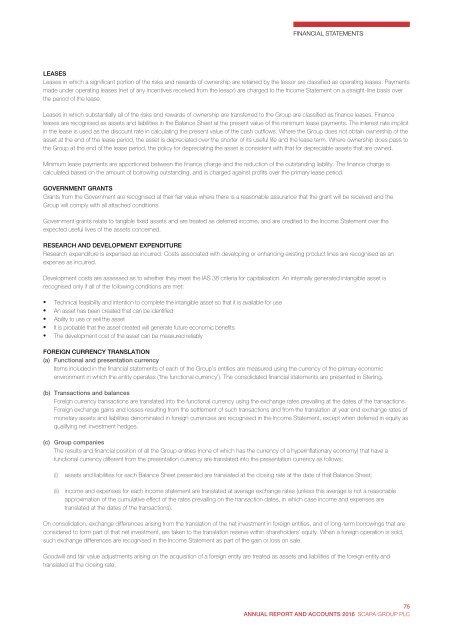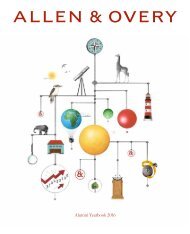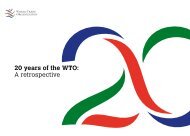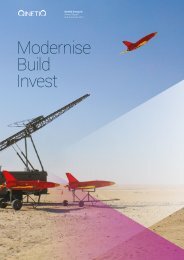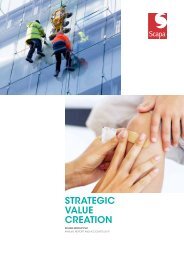20645_Scapa_AR_160504
Create successful ePaper yourself
Turn your PDF publications into a flip-book with our unique Google optimized e-Paper software.
GROUP ACCOUNTING POLICIES CONTINUED<br />
FINANCIAL STATEMENTS<br />
LEASES<br />
Leases in which a significant portion of the risks and rewards of ownership are retained by the lessor are classified as operating leases. Payments<br />
made under operating leases (net of any incentives received from the lessor) are charged to the Income Statement on a straight-line basis over<br />
the period of the lease.<br />
Leases in which substantially all of the risks and rewards of ownership are transferred to the Group are classified as finance leases. Finance<br />
leases are recognised as assets and liabilities in the Balance Sheet at the present value of the minimum lease payments. The interest rate implicit<br />
in the lease is used as the discount rate in calculating the present value of the cash outflows. Where the Group does not obtain ownership of the<br />
asset at the end of the lease period, the asset is depreciated over the shorter of its useful life and the lease term. Where ownership does pass to<br />
the Group at the end of the lease period, the policy for depreciating the asset is consistent with that for depreciable assets that are owned.<br />
Minimum lease payments are apportioned between the finance charge and the reduction of the outstanding liability. The finance charge is<br />
calculated based on the amount of borrowing outstanding, and is charged against profits over the primary lease period.<br />
GOVERNMENT GRANTS<br />
Grants from the Government are recognised at their fair value where there is a reasonable assurance that the grant will be received and the<br />
Group will comply with all attached conditions.<br />
Government grants relate to tangible fixed assets and are treated as deferred income, and are credited to the Income Statement over the<br />
expected useful lives of the assets concerned.<br />
RESE<strong>AR</strong>CH AND DEVELOPMENT EXPENDITURE<br />
Research expenditure is expensed as incurred. Costs associated with developing or enhancing existing product lines are recognised as an<br />
expense as incurred.<br />
Development costs are assessed as to whether they meet the IAS 38 criteria for capitalisation. An internally generated intangible asset is<br />
recognised only if all of the following conditions are met:<br />
<br />
<br />
<br />
<br />
<br />
Technical feasibility and intention to complete the intangible asset so that it is available for use<br />
An asset has been created that can be identified<br />
Ability to use or sell the asset<br />
It is probable that the asset created will generate future economic benefits<br />
The development cost of the asset can be measured reliably<br />
FOREIGN CURRENCY TRANSLATION<br />
(a) Functional and presentation currency<br />
Items included in the financial statements of each of the Group’s entities are measured using the currency of the primary economic<br />
environment in which the entity operates (‘the functional currency’). The consolidated financial statements are presented in Sterling.<br />
(b) Transactions and balances<br />
Foreign currency transactions are translated into the functional currency using the exchange rates prevailing at the dates of the transactions.<br />
Foreign exchange gains and losses resulting from the settlement of such transactions and from the translation at year end exchange rates of<br />
monetary assets and liabilities denominated in foreign currencies are recognised in the Income Statement, except when deferred in equity as<br />
qualifying net investment hedges.<br />
(c) Group companies<br />
The results and financial position of all the Group entities (none of which has the currency of a hyperinflationary economy) that have a<br />
functional currency different from the presentation currency are translated into the presentation currency as follows:<br />
(i)<br />
assets and liabilities for each Balance Sheet presented are translated at the closing rate at the date of that Balance Sheet;<br />
(ii) income and expenses for each income statement are translated at average exchange rates (unless this average is not a reasonable<br />
approximation of the cumulative effect of the rates prevailing on the transaction dates, in which case income and expenses are<br />
translated at the dates of the transactions).<br />
On consolidation, exchange differences arising from the translation of the net investment in foreign entities, and of long-term borrowings that are<br />
considered to form part of that net investment, are taken to the translation reserve within shareholders’ equity. When a foreign operation is sold,<br />
such exchange differences are recognised in the Income Statement as part of the gain or loss on sale.<br />
Goodwill and fair value adjustments arising on the acquisition of a foreign entity are treated as assets and liabilities of the foreign entity and<br />
translated at the closing rate.<br />
70<br />
<strong>Scapa</strong> Group plc Annual Report and Accounts 2016<br />
75<br />
ANNUAL REPORT AND ACCOUNTS 2016 SCAPA GROUP PLC


